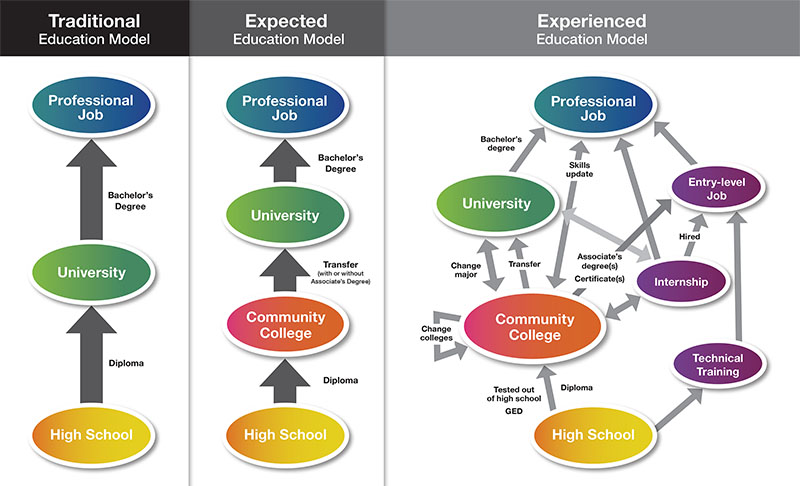The "Pipeline" to CS Careers: The Metaphor is Wrong
By Louise Ann Lyon, PhD | August 22, 2017
Senior Research Associate, ETR
Imagine a high school student who loves technology. She’s decided to pursue a career in computer science (CS). What steps will take her forward from school to career?
Planning for these steps is an essential part of the educational process, both for individual students and for educational institutions. Unfortunately, the current ways most institutions are thinking about the CS pipeline—or even the more flexible model of pathways—aren’t workable for a lot of students. In fact, using these traditional metaphors does a disservice not only to students, but to our nation’s critical need to train STEM professionals.
Tradition: What Educators—and Many Students—Expect
In the “classic” pathway, a student enrolls in a four-year college, graduates with a degree after senior year and enters the workforce. But this only works for people who have the resources to apply and be accepted to, then pay for and attend, a university. That is not possible for a lot of women and underrepresented minorities who would like to pursue computer science.
Our nation needs more technology workers. And we need a more diverse technology workforce. Community colleges are a resource that could help us achieve these ends. They’re easier to access, less expensive and more diverse than four-year universities. Over half of community college students are people of color, and there is high minority participation in computer sciences. Students could complete two initial years in a more affordable community college setting, then transfer to a four- year institution.
So instead of the three-step pathway of (1) high school, (2) university, and (3) career; students would have a four-step pathway of (1) high school, (2) community college, (3) university, and (4) career. But here’s the big problem with this model: this isn’t the actual experience of most community college students pursuing CS degrees.
The Real Picture for Community College Students
Our research shows that in fact most students who take the community college route are likely to follow a much more circuitous pathway. They need to take time off from their studies to earn money or help out their family financially. Or they need to work while pursuing their studies, which limits the time and effort they have for school, the number of classes they can take or the available schedule they have for classes. Or they need to start their college studies with remedial math classes, which puts them off sequence for all other courses. Or they drop and re-enroll in classes in an effort to bring up their GPA.
Creating and following a plan to transfer to a four-year institution is greatly complicated by the fact that different universities have different requirements for transfer admissions. Students often don’t have clear ideas about how best to prepare themselves. Many have received incorrect advising. They find themselves missing essential coursework, or unable to schedule a realistic sequence for the classes they do need, or stymied as they try to fit the necessary courses into the other demands of their lives.
This is abundantly clear in our schematic for the Traditional Model, the Expected Model, and the actual disruptions students report in the Experienced Model.
(Click here to see a larger version.)
Faulty Metaphors Contribute to Disappointing Outcomes
The idea that students follow a standard “pipeline,” or even a focused “pathway,” is too simplistic. This creates a misalignment between the policies and practices set up by educational institutions that employ these metaphors, and the convoluted routes community college students typically take towards their degrees. In one recent study looking at a national dataset of 3,290 community college students, researchers identified over 1,200 distinct paths to a CS bachelor’s degree!
If we’re serious about expanding the so-called pipeline and diversifying the technology workforce, let’s work with metaphors that better represent the lived experiences of these students. We need to recognize and be more responsive to the twists and turns of the CC student pathways—a uniquely discovered path is more likely than a straight-ahead pipeline. We also need to work towards simplifying these pathways in ways that support less traditional, more diverse students.
5 Practical Steps
Here are five practical steps we can take towards these goals.
- Strengthen advising and support. Support from faculty, counselors and peers is important to non-traditional CS and STEM students. Let’s make sure people in support roles have a strong understanding of the challenges and obstacles students face, along with a practical toolbox of solutions.
- Promote student-centered practices. We need policies and practices tailored to the particular challenges facing low-income and underrepresented students. That means more flexibility in scheduling coursework, clearer information about transfer requirements, and better ways of informing students about what CS careers are like.
- Be responsive to group differences and similarities. Existing research gives us some guidance here. Both women and men students benefit from encouragement by peers. CC women are more likely to persist in CS studies if they have opportunities to feel confident solving challenging problems. CC men benefit from positive interactions with their instructors and a personal value for computing. CC men of color benefit from personal connections with peers, faculty and staff, being held to high expectations, and having the opportunity to put what they learn into real-world practice.
We are not finished in this area of research. Group differences have genuine effects and we need to know more about them.
- Build stronger partnerships between four-year institutions and community colleges. Universities can reach out to CCs to build more authentic partnerships. This can include more faculty exchange between institutions and more opportunities that give CC students experiences at the four-year institution. Consider hackathons, open houses, regional conferences, websites, and access to university-based counselors and research faculty.
- Build greater involvement from industry. In some of our team’s research, we found that improved career knowledge and experience provided greater interest in pursuing CS majors. Unfortunately, many students did not understand what job skills employers wanted, or how to prepare for a specific job. Mentorships from tech professionals, real-world projects carried out as collaborations with CC classes, internships and other real-world experience can make a big difference for such students.
Community Colleges Hold an Important Key
As we continue the effort to expand our technology workforce and improve diversity in the field, I believe attention to the role of community colleges will be critical. I hope to see continuing focus on CC students and faculty, along with new research-based interventions that improve the career success of diverse students.
Louise Ann Lyon, PhD, is a Senior Research Associate at ETR. She brings industry experience in the software engineering workplace together with a research background to her focus on diversifying technology at postsecondary institutions and in the workplace. She can be reached at louann.lyon@etr.org.






